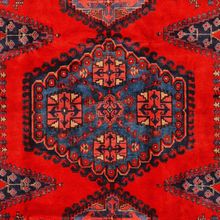Difference between revisions of "Viss Rug"
| Line 35: | Line 35: | ||
|additional info = | |additional info = | ||
}} | }} | ||
| − | Wiss rugs originate from Wiss, also referred to as Viss, a small town located near Hamadan. However, for a small town, Wiss has an eclectic mix of population. Kurds, Turks, and the nomadic people of Bakhtiari all call Wiss home, and it is the influence from these diverse groups that is an integral part of the weaving of wool rugs here. Due to its largely nomadic population, the majority of Wiss rugs feature geometric designs, which is an indication of a tribal rug. Its location so close to Hamadan has influenced the local weavers to create their wool rugs using the Hamadan weave, also referred to as the Sennah Baft. These wool rugs are woven with a Turkish symmetrical knot and a single shot of weft between the rows of knots | + | Wiss rugs originate from Wiss, also referred to as Viss, a small town located near Hamadan. However, for a small town, Wiss has an eclectic mix of population. Kurds, Turks, and the nomadic people of Bakhtiari all call Wiss home, and it is the influence from these diverse groups that is an integral part of the weaving of wool rugs here. Due to its largely nomadic population, the majority of Wiss rugs feature geometric designs, which is an indication of a tribal rug. Its location so close to Hamadan has influenced the local weavers to create their wool rugs using the Hamadan weave, also referred to as the Sennah Baft. These wool rugs are woven with a Turkish symmetrical knot and a single shot of weft between the rows of knots |
| − | |||
<!-- from Rugman Archive:https://web.archive.org/web/20070613055700/http://www.rugman.com:80/Content/wiss.html | <!-- from Rugman Archive:https://web.archive.org/web/20070613055700/http://www.rugman.com:80/Content/wiss.html | ||
#REDIRECT [[viss Rug]] | #REDIRECT [[viss Rug]] | ||
--> | --> | ||
| − | + | == History == | |
| + | == Materials == | ||
| + | === Foundation and Pile === | ||
| + | == Techniques and structures == | ||
| + | === Color and dyeing === | ||
| + | === Motifs and patterns === | ||
| + | === Weaving techniques === | ||
| + | == See also == | ||
| + | == References == | ||
| + | {{Reflist}} | ||
| + | == Bibliography == | ||
| + | Abraham Levi Moheban, (2015), ''[[The Encyclopedia of Antique Carpets|The Encyclopedia of Antique Carpets: Twenty-Five Centuries of Weaving]]'', NewYork: Princeton Architectural Press. | ||
[[Category:Persian Rug and Carpet]] | [[Category:Persian Rug and Carpet]] | ||
[[Category:Rug and Carpet]] | [[Category:Rug and Carpet]] | ||
[[fa:قالی_ویست]] | [[fa:قالی_ویست]] | ||
Revision as of 07:48, 4 December 2019
| Viss Rug | |
|---|---|
 Design of Viss Rug (Rugman) | |
| General information | |
| Name | Viss Rug |
| Original name | قالي ویست |
| Alternative name(s) | Viss Carpet |
| Origin | |
| Category | Village |
| Technical information | |
| Common designs | Geometric, Herati (Fish) |
| Common colors | Red, Beige, Blue, Navy Blue |
| Dyeing method | Natural, Synthetic |
| Pile material | Wool |
| Foundation material | Cotton |
| Knot type | Symmetrical (Turkish) |
Wiss rugs originate from Wiss, also referred to as Viss, a small town located near Hamadan. However, for a small town, Wiss has an eclectic mix of population. Kurds, Turks, and the nomadic people of Bakhtiari all call Wiss home, and it is the influence from these diverse groups that is an integral part of the weaving of wool rugs here. Due to its largely nomadic population, the majority of Wiss rugs feature geometric designs, which is an indication of a tribal rug. Its location so close to Hamadan has influenced the local weavers to create their wool rugs using the Hamadan weave, also referred to as the Sennah Baft. These wool rugs are woven with a Turkish symmetrical knot and a single shot of weft between the rows of knots
History
Materials
Foundation and Pile
Techniques and structures
Color and dyeing
Motifs and patterns
Weaving techniques
See also
References
Bibliography
Abraham Levi Moheban, (2015), The Encyclopedia of Antique Carpets: Twenty-Five Centuries of Weaving, NewYork: Princeton Architectural Press.